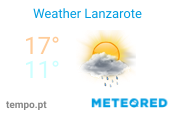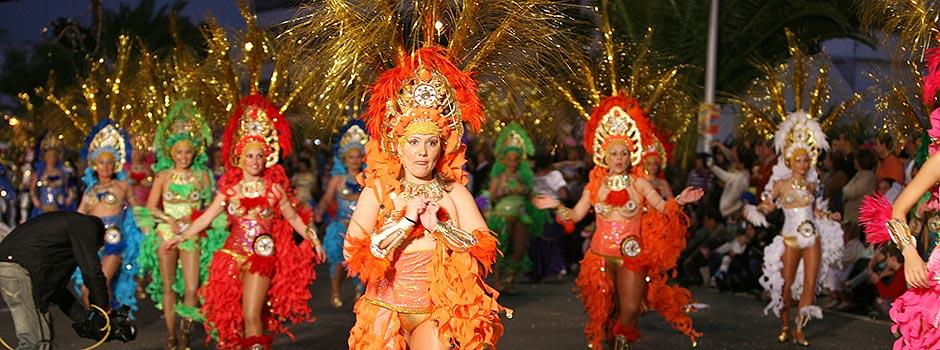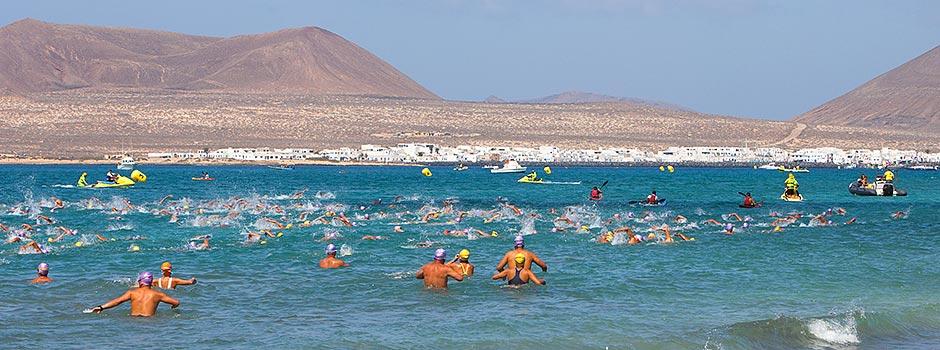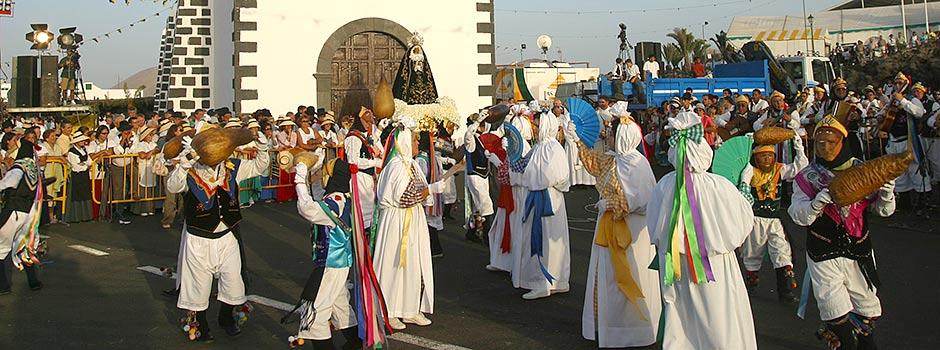January
Día de Reyes (King’s Day) – 6th January
The Epiphany is celebrated in Lanzarote like almost everywhere in the Christian world, with this day marking the end of the Christmas celebrations. In several towns, bonfires are lit in memory of those who, according to the legend, set Bethlehem on fire to hide the North Star from the King Herod.
Traditionally, in Spain, it is on this day that Christmas gifts are given to loved ones, as this was the day when the Three Wise Men gave their offerings to Baby Jesus.
On this occasion, shops all around the island sell the Kings’ Cake (Roscón de Reyes), which is made with the usual baking ingredients plus lemon and orange juice, brandy and orange flower water, covered with crystallised fruits and sliced almonds. Inside the cake there is always a small gift and a broad bean (tradition says that the person who gets the bean pays for the next cake).
The day before King’s Day, on 5th January, there is the spectacular Cabalgata de Reyes (Procession of the Three Wise Men) in Arrecife where the Three Wise Men parade through the capital on camels throwing sweets to the children.
February/March
Carnival
Carnival is the most attended celebration on the island, with thousands of people following the parades of floats. Some say that the origins of these festivities are religious, whilst others claim that they date back to pagan times. Exactly when Carnival begins and ends depends on the calendar and changes each year. It is a spectacular affair with outlandish costumes, music, dancing in the streets, drag queen competitions, a Carnival queen contest and performances of the murgas. These are large groups who dress up and perform satirical songs often substituting the lyrics of well-known tunes with their own humorous words to poke fun or make political statements. Then there are the comparsas who dance to the rhythm of samba tunes and the Parranda de los Buches (Arrecife) who have seafaring origins, wear traditional costumes and dance and sing while hitting spectators with dried fish bladders filled with air. In Teguise, you will find the Parranda de los Diabletes, who wear devil masks and ‘terrorise’ children in the streets.
It ends on, or in some places, after Ash Wednesday with the ‘Burial of the Sardine’, a peculiar ceremony, where men (who usually dress as women) pretend they are actually at the ‘funeral’ of the sardine, cry and mourn the fish before it gets cremated in a huge bonfire, marking the end of the Carnival celebrations.
March/April
Semana Santa (Holy Week)
During the Semana Santa – the week before Easter – you will be able to see solemn pre-Easter processions, where sacred icons and religious statues are carried through the streets of many villages and towns throughout the island.
May
Día de la Cruz (Day of the Cross) – 3rd May
This local fiesta is celebrated in Teguise and Tías, when residents decorate the front doors of their homes with crosses made from flowers.
Romería de San Isidro – 15th May
Uga, located in southern Lanzarote, is the stage for the Romería de San Isidro that takes place on 15th May. This festivity features a colourfully decorated procession accompanied by camels (as Uga is where camels are bred and raised) and various folklore performances.
Ironman Triathlon Competition
Among the professional competitions held each year in Lanzarote, the Ironman stands out as one of the most important triathlon events in the world. Around eight hundred athletes compete for points for the qualifying race as they attempt to complete a 2.4 miles (3.8 kilometre) swim, 112.5 miles (180 kilometre) bicycle ride and a 26.25 mile (42 kilometre) run, all in one day.
The race organisation and headquarters are located at Club La Santa on the north coast of the island.
Although the main event takes place on one day only, the event programme covers a few days, with fun runs, parties and award ceremonies.
Late May/Early June
Corpus Christi
The Corpus Christi celebrations take place in many cities, towns and villages all around the island. Nevertheless, these festivals acquire their greatest splendour in Arrecife. The preparations for this religious event start on early Saturday afternoon, when locals begin the construction of true masterpieces – vast carpets of dyed sea salt, coming from the Salinas de Janubio, embellish streets and squares with lively colours and pretty designs.
June
San Juan (Saint John)
Saint John’s celebrations mark the beginning of summer on the night from the 23rd to the 24th of June. During this night, huge bonfires are traditionally lit all over the island and corncobs are roasted, the festivities being accompanied by folkloric music and dance.
July
San Marcial del Rubicón
San Marcial del Rubicón is the patron saint of the island. During the first week of July it will be possible to see festivals in honour of this saint in several towns and villages, but his image is worshipped in the church that holds his name, located in the village of Femés in the south of Lanzarote.
Nuestra Señora del Carmen
The second fortnight of July is filled with the celebrations of the Nuestra Señora del Carmen in almost all villages and towns. Of special note are those happening in Teguise, Lanzarote’s former capital, along the coast of Puerto del Carmen, in Playa Blanca and in the fishermen’s village Caleta del Sebo, which is the main village on the islet of La Graciosa.
The processions include an image of the Virgin carried in a boat along the coast, accompanied by many decorated fishing boats which set out to sea filled with fishermen who are praying for a good catch in the year to come.
The fiestas of the Virgen del Carmen also feature many traditional activities, such as lucha canaria (Canarian wrestling), typical folklore performances, street parties and artisan fairs. You will be amazed at the amount of people coming to Teguise for this event to bring their offers to the Virgin.
August
San Ginés
The San Ginés celebrations are held in honour of the patron saint of Arrecife and go on for about a week with the big finale taking place on August 25th. These festivities include parades, processions and dancing in the streets of Arrecife.
September
Nuestra Señora de Los Remedios
This fiesta is held during the first week of September, with a colourful traditional pilgrimage leading to the Los Remedios church in Yaiza.
Nuestra Señora de Los Dolores
The legend has it that Nuestra Señora de los Dolores, also known as Virgin of the Volcanoes, was responsible for the salvation of the village of Mancha Blanca when a nearby volcano erupted and lava threatened to destroy everything. Every year residents make a pilgrimage to the church to give thanks to the Virgin for answering their prayers. Celebrations also include spectator sports, competitions and an artisan fair.
October
Visual Music Festival
The Visual Music Festival of Lanzarote is a cultural event of international importance. Organised since 1989 by the Government of Lanzarote together with the tourism department, this festival combines contemporary music with the island’s amazing natural assets.
The music festival takes place in two auditoriums, located in the volcanic caves of Jameos del Agua and Cueva de los Verdes in the northern part of the island. These are both outstanding sightseeing attractions and extraordinary venues that create a unique experience for both audience and performers.
Since the beginning of this festival, new venues have been discovered for exceptional concert performances, such as Volcán del Cuervo (the old volcanic ash quarry at Montaña del Tahíche) and the Santo Domingo Convent at Teguise.
November
International Running Challenge
It consists of four races in four consecutive days, in different locations and with different distances, attracting participants from all over Europe. The International Running Challenge is an event whose popularity has increased over the past 20 years. In this race, which takes place in November each year, people run for pleasure but, of course, for the competition itself.
Atlantic Odyssey
This is a family event and a favourite! The Atlantic Odyssey is an annual transatlantic boat race which takes place in November and in which participants sail from Lanzarote (or La Palma) to Martinique, in the Caribbean. A maximum of 60 boats crosses the ocean, so as to keep a spirit of interaction and camaraderie.
December
Navidad – Christmas Day
The night before Christmas Day, the 24th at night, is traditionally marked with Misa del Gallo (midnight mass) when many people attend a special service at church. On Christmas Day, families gather together and enjoy a large feast.
Santos Inocentes
The 28th of December is the day of the Santos Inocentes (literally ‘Innocent Saints’). This is the Spanish equivalent of April Fools’ Day, celebrated in many countries on 1st April, when tricks are played.
New Year’s Celebrations
New Year in Lanzarote is fun, easy-going and tradition-related. On New Year’s Eve, an occasion even more celebrated than Christmas, Lanzaroteños count every stroke of midnight while drinking cava, the local version for champagne, and eating 12 grapes (one for each stroke). As you can imagine, fast eating and drinking at the same time often becomes a truly hilarious experience.


























